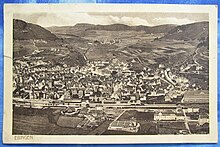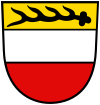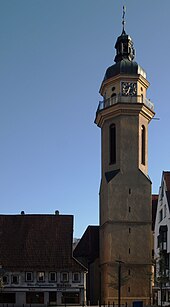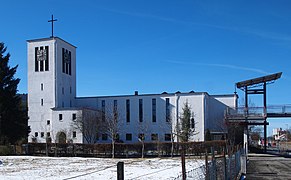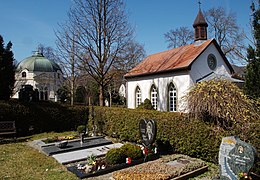Ebingen
|
Ebingen
City of Albstadt
|
|
|---|---|
| Coordinates: 48 ° 12 ′ 46 ″ N , 9 ° 1 ′ 29 ″ E | |
| Height : | 731 (714-966) m |
| Area : | 37.92 km² |
| Residents : | 19,573 (Jun 30, 2020) |
| Population density : | 516 inhabitants / km² |
| Incorporation : | 1st January 1975 |
| Postal code : | 72458 |
| Area code : | 07431 |
|
Location of Ebingen in the city of Albstadt
|
|
|
Ebingen from the Schleicherhütte
|
|
Since the merger in 1975, Ebingen has been the central and largest district of Albstadt in the Zollernalb district in Baden-Württemberg . It is located on the Swabian Alb , about halfway between Stuttgart and Lake Constance . Truchtelfingen is located to the north and Lautlingen is to the west .
history
Early history and the Middle Ages
The Roman fort Lautlingen was already located on the later district boundary of Ebingen and Lautlingen in early history .
Ebingen itself was first mentioned in a document in 793 in a deed of donation to the St. Gallen monastery . The place is certainly much older: A reference to this is not only the place name with the ending “-ingen”, but also numerous graves from the Merovingian period . At the moment, it is not possible to determine exactly when the settlement began in post-Roman times. It is to be expected that the situation on the Rauhen Alb led to a delayed settlement. A concentration of settlement in the area around the future city is evident from the burial grounds, but the largest burial site is west of the city in the valley of the Riedbach. The relatively favorable geographical location compared to the neighboring towns with a traffic connection through the Schmiecha - to the Danube valley and the connection via the European watershed and the pass near Lautlingen along the Eyach into the Neckar valley was certainly an important basis for further population development. Ebingen developed into a central place in the vicinity during the early and high Middle Ages. It became the seat of an ecclesiastical country dean's office and eventually received city rights. A town registration certificate has not been received; the earliest written reference to Ebingen's status as a town dates back to 1285, when a mayor Albrecht von Honstetten was named. It was probably the Counts of Hohenberg who made the place a city around 1260. In 1367 Ebingen came to the House of Württemberg as pledge , and in 1468 the city was finally confirmed as Württemberg property. Ebingen became the official city of Württemberg , but only the neighboring towns of Ehestetten and Bitz belonged to his district. In the city, however, there was a bailiff and Ebingen was also represented in the Stuttgart state parliament.
In the 15th century the Upper and Lower Suburbs emerged as an extension of the core city. They are an indication of a strong population growth that resulted from the immigration of rural populations from surrounding areas. West of Ebingen is a desert called Stetten, which was abandoned before 1560. The population of Ehestetten below the city was forcibly relocated sometime between 1453 and 1624, so that only one mill remained.
In the vicinity of Ebingen there are still remnants of Ehestetten Castle and Häringstein Castle from the 11th to 12th centuries, and Ebingen Castle was also in the urban area.
industrialization
The economic basis of the city was certainly the agricultural sector. Field names in the Ebingen area indicate the importance of livestock farming. Numerous slag finds that were made in the bed of the Schmiecha below the city point to a medieval iron smelting. After the Thirty Years War , the city's economic structure changed. There has been a significant increase in manual occupations, mainly in the textile sector. In 1664 we find no more than 15 weavers, but by 1788 their number had doubled; there were also 53 stocking workers , 77 fabric makers and 20 braid workers. Such an early focus on the textile sector had a lasting effect on industrialization in Ebingen. Its first beginnings lie in the work of the textile manufacturer Johannes Mauthe, known as "Löwen-Mauthe", who brought the first steam engine to Ebingen in 1834 and the first circular knitting machine in 1836.
The big breakthrough came in the 1870s (railway connection 1878). In addition to the manufacture of tricot goods, the production of velvet and Manchester fabrics became more important in Ebingen, and the manufacture of scales and the production of needles (Theodor Groz, now Groz-Beckert ) also played a decisive role. The general economic upturn caused a huge population increase. In 1820 the city had 4,126 inhabitants, in 1871 there were already 5,029, in 1895 then 7,600 and in 1910 finally 11,423.
Administrative history
Ebingen was a separate official town during the Duchy of Württemberg, but apart from Ehestetten and Bitz there were no other subordinate places of administration. With the establishment of the Kingdom of Württemberg Ebingen came to the Oberamt Balingen , but was able to function as the seat of a judicial office until 1819. Since 1819, the city was fully integrated into the Balingen District Office and became part of the district in 1934 and the district of Balingen in 1938 .
20th century
The First World War only affected Ebingen's economy temporarily; but the lack of raw materials and food aroused great resentment among the workers. The Ebinger reaction to the Nazi takeover was less brutal. The citizens showed no visible resistance when communists and trade unionists disappeared, when the few Jews from Ebingen were expelled, when associations and parties were induced to dissolve. The manufacturer Fritz Haux can be regarded as one of the few upright people , who fearlessly stood up for the liberals and was therefore temporarily in prison.
The Second World War brought more than 1,600 forced laborers to the city, half of them Russians. The war itself did not come to Ebingen until July 11, 1944 in the form of a bombing raid, in which 61 people were killed and 37 houses in the city center were destroyed.
During the Nazi era, Emil Hayer had been mayor of Ebingen since 1934; he was initially replaced by Eugen Rilling in 1944, but was again mayor in 1945. After the war, Albert Walker became mayor, but he was replaced by Fridolin Reiber in 1946, who was in office until 1948. From 1948–1960 (Lord) Mayor Walther Groz acted, during whose term of office the expansion of the city fell due to immigration (consequences of the war, economic miracle). In 1956 the population exceeded 20,000, which meant that Ebingen was allowed to carry the title of a major district town from now on ; the mayor thus became the mayor. In the 1950s the schools were expanded and the Schalksburg School was rebuilt in 1957; In 1956 a representative indoor pool was built.
After this development phase, a phase of consolidation began under Mayor Hans Hoss (1961–1975). During this time the bypass road ( B 463 ), the vocational school center, the grammar school and the new hospital building were built.
Margrethausen were incorporated on December 1, 1971, Lautlingen on May 1, 1972 and Laufen an der Eyach on May 1, 1973.
On January 1, 1975, the new town of Albstadt was founded and Ebingen was absorbed.
politics
Living spaces
Ebingen includes the following districts and residential areas : Ehestetter Hof , Ehestetter Mühle , Eselmühle , Fohlenweide, Galthaus, Im Degerwand, Im Kienten, Im Mehlbaum, Jausenteich, Oststadt, Petersburg, Sandgrube, Setze, Stopper, (Am) Schloßberg, Waldheim, Weiherwuhr, Weststadt and Weißenburg.
mayor
coat of arms
| Blazon : "Under the golden head of a shield, a black stag pole lying to the left, divided by silver and red." | |
| Reasons for the coat of arms: The colors silver and red stand for the County of Hohenberg (Upper Austria). The place was later sold to Württemberg, hence the stag pole, which Ebingen belonged to before it came to Württemberg. In addition, it was the Counts of Hohenberg who gave Ebingen city rights. The head of the shield indicates that it belongs to Württemberg. |
Population development
Population figures according to the respective area until 1970. From 1975 see Albstadt . The figures are census results (¹) or official updates from the respective statistical offices (main residences only).
|
|
|
The doubling of the population within 30 years (from 1880 to 1910) as a result of the railway connection in 1878 and the flourishing textile and metal processing industry is significant.
Culture and sights
Ebingen is on the Hohenzollernstrasse and the Swabian Albstrasse .
Museums
- Städtische Galerie Albstadt with the permanent themes of the landscape of the Swabian Alb , works by Christian Landenberger (1862–1927) and Otto Dix (1891–1969)
- Herb box : regional museum of natural history and archeology
- Local history museum: The museum was founded in 1926 and has an eventful history behind it. It was originally located in the attic of the Ebingen town hall, where it was seriously damaged in the bombing raid in July 1944. It was restored after the war. In the course of the post-war period it was used more and more for art exhibitions. After Albstadt was founded in 1975, it had to give way because the attic of the town hall was used as the council chamber of the now much larger city. The exhibits of the local history museum were mothballed, the works of art found a new domicile in the Protestant clubhouse, today the municipal gallery. It was not until the 1980s that the Ebinger Heimatmuseum (local history museum) association came together and finally managed to reopen the Heimatmuseum in 1996 in the old school on the Spitalhof, initially under the somewhat misleading name of Ebinger Heimatstuben , and then again under its original name from 1999.
Buildings
Churches
- Evangelical Martinskirche, tower from 1670, neo-baroque church with Art Nouveau decorative elements. As early as the 7th century, a church was built on this site over an Alemannic burial ground, and an early Gothic round pillar basilica later took its place. This church was mentioned for the first time in 1270, and in 1342 it appeared as St. Martin's Church. A women's chapel, donated in 1382, was rebuilt in 1490. In the church there is the gravestone of the knight Heinrich von Ringelstein, called "Affenschmaltz", from 1413. His family castles were Hohenringingen and Ringelstein Castle . After long discussions in the community, most of the St. Martin's Church was demolished in 1905 because it was dilapidated and a representative new building in contemporary forms with an impressive facade facing south was erected by 1906. The old, late Gothic choir (1473) and the tower renewed in 1670 were included in the new building. The design came from the Stuttgart architects Paul Schmohl and Georg Stähelin .
In the Middle Ages there were no cemeteries near the chapels in Heinstetten and Hossingen . The residents were buried in Ebingen near the Martinskirche. The path via Meßstetten Castle and the “Siebenkreuzlesweg” is still known today as the Path of the Dead . “All residents, men and women, young and old, have belonged to Hossingen from time immemorial, dead and alive in the parish of Ebingen. But they are now being provided by a pastor in Meßstetten in 1564. "
- The hermitage next to the Martinskirche was inhabited by terziarinnen from 1344 to 1608 . The roof structure contains beams from 1427.
- The Protestant Kapellkirche was founded in 1382 "in honor of Our Lady and the Holy Sepulcher in Jerusalem". The current building dates from 1490 and was renovated in 1833.
The city was the seat of a deanery. After the Reformation she was assigned to the dean's office in Balingen. The population increase in the town of Ebingen after the Second World War made it necessary to build more churches and establish more parishes. Together with the old Martin’s Church, the Protestant churches form the Evangelical General Church Community of Ebingen, which belongs to the Balingen deanery of the Evangelical Church in Württemberg .
- Evangelical Peace Church, built in 1931 in the New Building style , now located in an industrial area
- Evangelical St. Thomas Church in Oststadt, built in 1962
- Emmaus Church in the Ebingen-West district
- Catholic Church of St. Joseph, neo-Gothic brick building: In the course of industrialization, Ebingen's Catholic population had increased considerably, so that in 1892 it was given its own house of worship. As the number of Catholics continued to grow after the church was completed, an expansion was necessary in 1912.
- Catholic Holy Cross Church in the Oststadt, built in 1965
- Catholic Church St. Hedwig in Ebingen-West, built in 1973
Secular buildings

Little remains of the former city fortifications. The town tower from around 1500, one of Ebingen's landmarks, is striking. Also worth mentioning are the so-called Malefizturm and the only visible piece of the city wall right next to it.
Notable half-timbered houses:
- The herb box dates from the second half of the 15th century with beautiful Alemannic half-timbering. It was originally used as a granary for the Württemberg authorities and in the 19th century for storing herbs. Today this building houses a small museum for natural history and archeology and a citizens' meeting place.
- The old school served as a parsonage before the Reformation and as a school after the Reformation. The current building dates back to 1717. Today the Swabian Alb Association and the Ebingen local history museum are housed here.
- The old chancellery was built in the 15th century and served until the construction of the town hall in 1913 as the town school chancellery and thus the seat of the town administration.
- The hospice is a striking half-timbered house in which the Ebingen bailiff once resided. The building burned down in 1731 and was then rebuilt. In 1885 it came into the possession of the Evangelical Association, to which it belonged until a few years ago. In 2011 the listed building was completely renovated.
More Attractions:
- Market fountain with a figure of a knight (Renaissance knight) from 1545, popularly known as "Duke Ulrich". The figure was replaced by a copy around 1960, the original is now in the city library.
- Ebingen town hall, built in 1912/1913 in reform style with Art Nouveau influences based on designs by Stuttgart architect Martin Elsaesser with city architect Leonhard Schrein. It is provided with a massive gable facing Marktstrasse as well as with numerous decorative elements that were donated by Ebingen citizens at the time.
- In 1991, in the pedestrian zone of Ebingen, fat comic characters with bare buttocks, designed by Ernst-Reinhart Böhlig, were set up, which he called "Xingles" and which have since shaped the old town of Ebingen. These sculptures are controversial, not least because a historic old town fountain had to be relocated for their installation.
- Numerous factories from around 1900 in Ebingen. The former Traugott Ott velvet factory, which was built in 1897, the former Gottlieb Ott & Sohn velvet factory and the former Gottlieb Kern scales factory may be mentioned as selections.
- The factory owners' residences, such as the two Haux villas (the old Villa Haux was moved to the other side of Gartenstrasse in a spectacular building in 1907 to make way for the new Villa Haux).
Sports
The Ebingen winter sports club maintains the longest drag lift in the south-west Alb with a length of 600 meters. There is also a snow-making system. There is also a small 60-meter-long lift available for children and those practicing, and there is also a groomed trail that is around five kilometers long.
In addition to winter sports, cycling is one of the most popular sports in the region. The nationally known Albstadt Bike Marathon takes place every summer .
FC 07 Albstadt , based in Ebingen, is the city's largest football club and has been playing in the Württemberg League since 2010/11 .
Agriculture
In addition to agriculture and cattle breeding, fruit and vegetables are also grown in Ebingen. The tree maintenance trained in Hohenheim once operated two tree nurseries in Ebingen. In 1880, fruit growing expanded according to the Oberamt description: “Late fruit likes to come. Luikenapfel and plums predominate. The community has a tree nursery, as does a private citizen; but the young lines are mostly obtained from Laufen, Dürrwangen and Zillhausen. Some of the fruit is tasted, but mostly eaten green ”. In 1878 Ebingen had 470 tall pear trees, 3000 apple trees, 1200 plums and plums and 200 cherry trees. In addition to private gardens, avenues were also planted. King Wilhelm used an easement of the roads for planting on foreign land. The nurseries of the Brethren also gave away fruit trees in the area. On the old road to Straßberg ( 48 ° 11 ′ 35.96 ″ N , 9 ° 4 ′ 5.8 ″ E ) further rows of landowners were replanted. The originally preserved avenue is owned by the state of Baden-Württemberg, the adjacent trees are privately owned. At this section, the road was laid over the railway line, so the wide trees do not interfere here and could be preserved. In 2018, the hedges under the avenue trees were milled away, and 15 replanting of historical pear tree varieties were carried out in autumn. The robust fruit varieties are made available as standard trunks from the nature conservation center in Beuron via bulk orders. Today, a professional fruit growing consultant in the district office supports the cultivation of orchards while taking ecological aspects into account. NABU also takes care of the orchards.
The orchards are not only so valuable because of their landscape-defining importance, but also because of their ecological wealth. They offer a habitat for many endangered animal and plant species and serve as a local recreation area. Above all, the old varieties, which are now almost unknown, turn out to be special aromatic carriers when they are further processed into fruit specialties.
education
Ebingen has many schools as well as higher educational institutions.
- Church pit school
- Oststadtschule
Elementary, secondary and technical secondary schools :
- Schalksburg School
- Hohenberg School
Secondary school:
- Schlossberg secondary school
Gymnasiums:
- Ebingen grammar school (general education grammar school )
Vocational schools / vocational high schools:
- Business High School ( Walter Groz School )
- Home economics school with a nutritional and biotechnological high school
University:
- Albstadt-Sigmaringen University of Applied Sciences
- State seminar for didactics and teacher training (primary and secondary schools)
Personalities
Sons and daughters of the place
- Ernst Biekert (1924–2013), chemist and manager
- Konrad Blicklin (called Konrad Ebinger, around 1462–1534), law professor in Tübingen
- Karl Bodmer (1911–1955), motorcycle racer
- Birgit Cramon Daiber (* 1944) politician (Die Linke, Bündnis 90 / Die Grünen), MEP
- Antje von Dewitz (* 1972), entrepreneur
- Wilhelm Dodel (1850–1934), legendary chief magistrate in Marbach am Neckar and Blaubeuren ("the Swabian Solomon"); for it is Wilhelm Dodel alley named in Ebingen
- Franz Dreher (1898–1977), politician
- Hans Fäh (1916–1984), watercolor painter
- Walther Groz (1903–2000), factory owner and Lord Mayor of Ebingen 1948 to 1960
- Friedrich Haux (1860–1929), manufacturer
- Friedrich Haux (1887–1966), manufacturer and politician
- Johannes Jehle (1881–1935), organ builder, composer, music publisher, choir director
- Martin Friedrich Jehle (1914–1982), piano builder, choir director, music historian
- Volker Jehle (* 1954), writer, literary scholar, editor
- Andreas Jetter (* 1978), pianist, organist, church musician
- Kurt Georg Kiesinger (1904–1988), Federal Chancellor of the Federal Republic of Germany, Kurt-Georg-Kiesinger-Platz in Ebingen is named after him
- Konrad Klek (* 1960), Protestant theologian, pastor, organist, church musician, university music director and university professor
- Karl Klunzinger (1799–1861), pastor, writer and local history researcher
- Hans-Ulrich Küpper (* 1945), Professor of Business Administration
- Johann Martin Landenberger (1804–1873), entrepreneur, member of the state parliament
- Paul Landenberger (1848–1939), businessman and watch manufacturer
- Christian Landenberger (1862–1927), impressionist painter (landscape paintings) and professor at the Stuttgart Art Academy
- Matthias Maute (* 1963), recorder player and composer
- Martin Rominger (* 1977), multiple world champion in artificial cycling
- Johann Christoph von Schmid (1756–1827), theologian, general superintendent in Ulm
- Günther Schweizer (1938–2020), geographer and genealogist
literature
- Festive report on the fiftieth anniversary celebration of the Augustenhilfe rescue facility in Ebingen. Also fiftieth annual report. Printing by the “Alb-Bote” corporation in Ebingen. 1890.
- Voices of comfort at a child's grave. Letters from outstanding German theologians of our century. With a preface [and edited] by pastor Fr. [riedrich] Jehle. Stuttgart: Evangelical Society 1897; the letters are all addressed to the Ebingen teacher Stengel after the death of his 4½-year-old daughter in 1854 by scarlet death.
- Commemorative sheets for the evangelical community Ebingen. Booklet 1st price 20 Pfennig. The proceeds will go to the cemetery chapel. Self-published by the parish council. On commission from Ulrich Nefflen in Ebingen. 1897.
- Pictures from Ebingen and the surrounding area. Dedicated to the autumn meeting of the Swabian Alb Association. Ebingen October 14, 1906. Printed in the cooperative printing house of the "Neuen Alb-Boten" Ebingen; Folder with 3 large and 7 smaller black and white photo panels.
- Thank God Fr. Hummel: War chronicle of the town of Ebingen . JF Steinkopf publishing house , Stuttgart 1919.
- Thank God Fr. Hummel: History of the city of Ebingen . Ebinger Druckerei, 1st edition 1923, 2nd edition Ebingen 1936.
- Thank God Ms. Hummel. The weather banner. Local history novel based on manuscripts, documents, church registers and oral traditions. Published by Ulrich Nefflen, Inh. G. [ustav] Glock, Buchhandlung, Ebingen. [1927]
- War chronicle of the Protestant parish Ebingen for the period 1933–1948. Written by pastor [Edmund] Jahn (pp. 1–42 and pp. 52–56) and church clerk [Karl] Maute (pp. 43–51). Ebingen 1948 [unprinted].
- Johannes Jerg: Chronicle of the bleacher Johannes Jerg, 1771-1825. A home book of the city of Ebingen. (Text transfer from the original by J. Halm. Drawings by O. Wider). Daniel, Balingen 1953.
- The evangelical church district Balingen, edition B. Ebingen and surrounding communities. Published by the evangelical pastors of the district. Evangelisches Verlagswerk Stuttgart 1954. 82 pages, with photos.
- Ebingen. Published by the city administration of Ebingen. [Printed in Reutlingen by Enßlin & Laiblin in 1956 at the earliest].
- Large district town of Ebingen. Ceremony on August 4, 1956 on the occasion of Ebingen's declaration as a major district town. Ebingen: City administration 1957.
- Joseph Halm: City mirror Ebingen. A handbook for locals and our guests. Rothenburg / Tauber: Gerhard Wasserthal [1958 at the earliest].
- The city of Ebingen. Reprint from “Der Landkreis Balingen”. Official district description Volume II. Published by the Baden-Württemberg State Statistical Office in conjunction with the Balingen district in 1961.
- Martin Friedrich Jehle: 1000 years of music in Ebingen. Ebingen 1975, 244 pp. [Unprinted].
- Erich F. Jetter (Ed.): Alt-Ebingen and its surroundings. Photographic memories. Balingen: Hermann Daniel 1982; Volume II. Balingen: Hermann Daniel 1984.
- Eberhard Blum / Thaddäus Lang: Jews in Ebingen? In: Heimatkundliche Blätter in Balingen (or Zollernalb) vol. 35 (1988), pp. 662-663. (With the naming of the Jewish citizens between 1929 and approx. 1939 and their fate)
- Walter Stettner: Ebingen. The history of a city in Württemberg. Thorbecke, Sigmaringen 1986. ISBN 3-7995-4094-6
- Wilhelm Maute: Forgotten events from five centuries, happened in the city of Ebingen . Silberburg, Tübingen 2000.
- Elmar Frey: Ebingen . Sutton, Erfurt 2002. ISBN 3-89702-423-3
- Jürgen Scheff: 75 years of museums in Albstadt. Ebinger Heimatmuseum 1926–2001. Albstadt city administration, Albstadt 2002.
- Otto Klaiber: Memoirs of a contemporary witness from Ebingen. Self-published, Albstadt-Ebingen 2004.
- Wilhelm Maute: Trade and Commerce in Transition. 150 years of Ebingen's economic history . Daniel, Albstadt-Ebingen 2004. ISBN 3-925012-38-9 .
- Roger Orlik: By plane via Ebingen. Aerial photos from 1927. SP-Verlag, Albstadt 2005.
- Peter Th. Lang: Ebingen. The fifties. Sutton, Erfurt 2006. ISBN 3-86680-011-8
- Peter Th. Lang: Ebinger Legends. Distinctive personalities from the 19th century. SP-Verlag, Albstadt 2007.
Web links
Individual evidence
- ↑ D. Weber, Die Wüstungen in Württemberg , Stuttgart 1927 p. 30
- ^ Federal Statistical Office (ed.): Historical municipality directory for the Federal Republic of Germany. Name, border and key number changes in municipalities, counties and administrative districts from May 27, 1970 to December 31, 1982 . W. Kohlhammer, Stuttgart / Mainz 1983, ISBN 3-17-003263-1 , p. 525 and 540 .
- ^ Federal Statistical Office (ed.): Historical municipality directory for the Federal Republic of Germany. Name, border and key number changes in municipalities, counties and administrative districts from May 27, 1970 to December 31, 1982 . W. Kohlhammer, Stuttgart / Mainz 1983, ISBN 3-17-003263-1 , p. 540 .
- ^ Pastor Hermann Dreher: Heimatklänge . Community letter from the Evangelical Church Community of Messstetten. Messstetten 1909.
- ↑ Ebingen Franciscan Convent - History , Baden-Württemberg State Archives
- ↑ Who will save the former Ebinger Klause? Schwarzwälder Bote , October 8, 2014
- ^ Dennis Knappe: Winter Sports. The region's ski lifts start operating . In: Schwäbische Zeitung from November 28, 2008
- ↑ http://www.albstadt-bike-marathon.de/ www.albstadt-bike-marathon.de
- ↑ Description of the Oberamt Balingen / Chapter B 5 Oberamtsbeschreibung 1880 Balingen, page 322
- ↑ Apple history on Apfelgut Sulz
- ↑ Fruit growing table on page 171, description of the Balingen District Office .
- ↑ Orchard conception
- ↑ Nature Conservation Center Obere Donau ( Memento of the original from March 10, 2018 in the Internet Archive ) Info: The archive link was inserted automatically and has not yet been checked. Please check the original and archive link according to the instructions and then remove this notice. .
- ↑ Fruit growing specialist Zollernalbkreis .
- ↑ NABU






